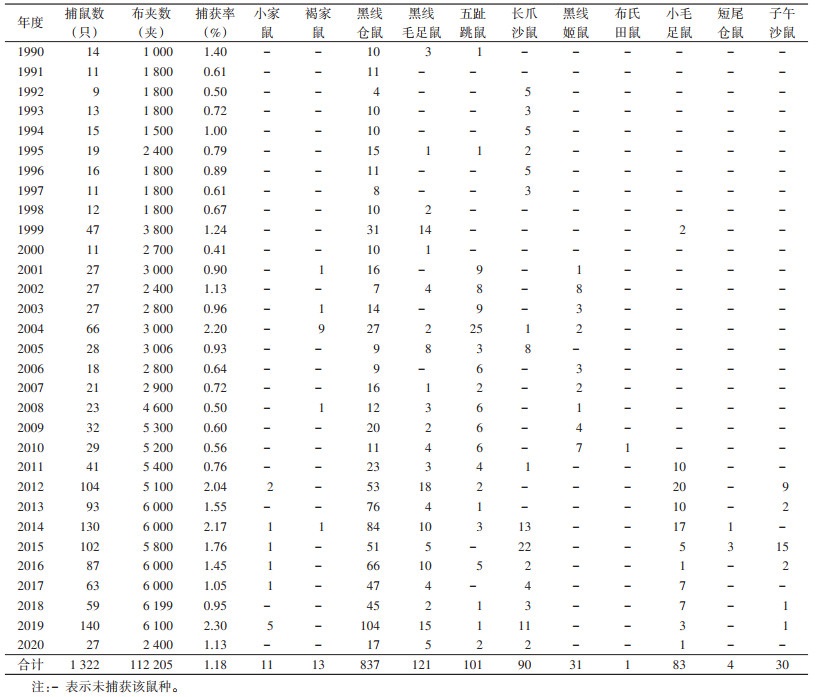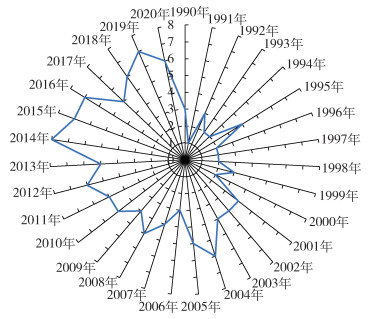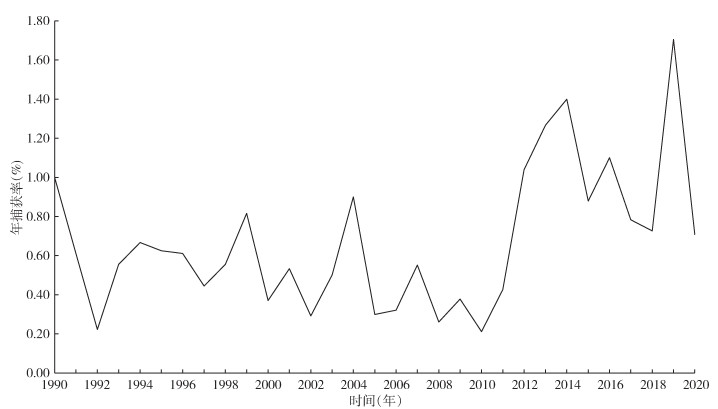扩展功能
文章信息
- 陈永明, 康东梅, 闫萍, 杨顺林, 白雪薇, 周松, 王海峰, 郑楠, 杜国义, 陈凯乐
- CHEN Yong-ming, KANG Dong-mei, YAN Ping, YANG Shun-lin, BAI Xue-wei, ZHOU Song, WANG Hai-feng, ZHENG Nan, DU Guo-yi, CHEN Kai-le
- 河北省鼠疫自然疫源地1990-2020年小型鼠监测结果分析
- An analysis of surveillance results for small rodents in natural plague foci of Hebei province, China, 1990-2020
- 中国媒介生物学及控制杂志, 2022, 33(1): 89-93
- Chin J Vector Biol & Control, 2022, 33(1): 89-93
- 10.11853/j.issn.1003.8280.2022.01.016
-
文章历史
- 收稿日期: 2021-04-13
2 张家口市地方病防治所, 河北 张家口 075000
2 Zhangjiakou City Endemic Disease Prevention and Control Center, Zhangjiakou, Hebei 075000, China
河北省鼠疫自然疫源地位于河北省康保县境内,地处阴山山脉东端,为典型的大陆性气候,是内蒙古长爪沙鼠(Meriones unguiculatus)鼠疫自然疫源地向南延伸入河北的部分,与内蒙古自治区(内蒙古)太卜寺旗、正镶白旗和化德县相连。1971年12月26日在康保牧场自毙长爪沙鼠体内检出鼠疫耶尔森菌(鼠疫菌),证实河北省鼠疫自然疫源地的存在[1]。1990-2020年共发生动物间疫情4次,检出鼠疫菌115株,染疫动物有长爪沙鼠、达乌尔黄鼠(Spermophilus dauricus)、黑线仓鼠(Cricetulus barabensis)、黑线毛足鼠(Phodopus sungorus)和狭颅田鼠(Microtus gregalis),除达乌尔黄鼠外,均为小型鼠[2]。在动物间鼠疫监测工作中,了解小型鼠的密度、群落结构动态变化是反应疫源地是否存在动物鼠疫流行风险的可靠途径。本文通过分析1990-2020年河北省鼠疫疫源地小型鼠调查数据,了解其种类动态变化规律,为鼠疫疫源地动物疫情预测预警提供必要依据。
1 材料与方法 1.1 监测方法按照《全国鼠疫监测方案》和《河北省鼠疫防治所工作方案》对河北省鼠疫自然疫源地宿主动物进行监测。采用5 m夹线法调查小型鼠数量,以月为单位,选择有代表性的1~3种生境,每种生境布夹100夹,日落后布夹,日出前收回,在布夹时间内遇到风雨时,不再计算捕获率。
1.2 资料来源1990-2020年河北省鼠疫自然疫源地监测数据资料来源于河北省鼠疫防治所和河北省张家口市康保县疾病预防控制中心专题监测报告。
1.3 数据分析应用Excel 2010软件对野外小型鼠调查数据进行总结和逐年逐月统计,运用集中度法对其季节分布特征进行分析。

|
集中度(M)说明传染病的群体现象在1年中的集中程度。M=1时,表示最大极限,说明1年内的疾病总数集中在1个月内;M=0时,表示最小极限,说明1年内的疾病总数均匀分布在12个月内;M≥0.9时,说明疾病有严格的季节性;0.7≤M < 0.9,说明疾病有很强的季节性;0.5≤M < 0.7,说明疾病有较强的季节性;0.3≤M < 0.5,说明疾病有一定的季节性;M < 0.3,说明疾病的时间分布比较均匀。集中度的公式计算如下:

|
(1) |

|
(2) |

|
(3) |
式中,M表示集中度,r表示某月小型鼠捕获数与其全年捕获数总和之比,下角标表示月份。R表示离散度。
2 结果 2.1 小型鼠调查结果共计布放鼠夹112 205夹次,捕鼠1 322只,平均捕获率为1.18%,其中2019年最高,2004年次之,2000年最低,捕获率分别为2.30%、2.20%和0.41%;高于平均捕获率的有9个年份,即1990、1999、2004、2012-2016和2019年。见表 1。

|
共捕获小型鼠4科8属11种,其中以黑线仓鼠最多,占63.31%,为优势种,其次是黑线毛足鼠9.15%,五趾跳鼠7.64%和长爪沙鼠6.81%,其他7种鼠类共占比13.09%。小型鼠种类变化趋势为逐渐增多,以2014年最多,有8种,最少的年份是1991年,仅有1种。见图 1。

|
| 注:图中数字代表每年监测到的小型鼠种数。 图 1 河北省鼠疫自然疫源地1990-2020年小型鼠种类数量变化规律 Figure 1 Changes in the number of small rodent species in plague natural foci of Hebei province from 1990 to 2020 |
| |
集中度法研究发现M=0.13,小型鼠数量在全年分布比较均匀。在常规监测的4-7、10和11月基本均可以捕获小型鼠,相对数量较多的是6月(247/1 322,18.68%)、7月(259/1 322,19.59%)和10月(250/1 322,18.91%)。见图 2。

|
| 图 2 河北省鼠疫自然疫源地1990-2020年小型鼠捕获率变化趋势 Figure 2 Changing trend in the capture rate of small rodents in plague natural foci of Hebei province from 1990 to 2020 |
| |
对优势鼠种黑线仓鼠进行分析发现,其年捕获率与小型鼠整体的趋势基本一致,最高峰均出现在2019年(1.70%)(图 3)。季节性研究M=0.30,黑线仓鼠的密度变化有一定的季节性,夏秋季相对较高,10月最高,其次是7、6和11月,捕获率分别为0.98%、0.82%、0.71%、0.71%。

|
| 图 3 河北省鼠疫自然疫源地1990-2020年黑线仓鼠捕获率变化趋势 Figure 3 Changing trend in the annual capture rate of Cricetulus barabensis in natural plague foci of Hebei province from 1990 to 2020 |
| |
目前,我国有12类鼠疫自然疫源地,染疫动物88种,涉及2纲(哺乳纲、鸟纲)8目19科56属,其中啮齿目6科30属53种[3],除了14种主要宿主外,其他均为次要宿主和偶然宿主[4]。1990-2020年河北省捕获的小型鼠类均有检出鼠疫菌记录[5]。1970-1972年内蒙古西部动物鼠疫大流行,流行程度之猛烈,波及范围之广,染疫动物之多,历史罕见[6]。疫源地内包括长爪沙鼠、达乌尔黄鼠、黑线仓鼠、黑线毛足鼠、子午沙鼠(Meriones meridianus)、五趾跳鼠(Allactaga sibirica)、三趾跳鼠(Dipus sagitta)、小家鼠(Mus musculus)等15种常见鼠种均检出鼠疫菌[7]。由此可见,鼠种的多样性更利于动物鼠疫的扩散和传播。
安君胜[8]研究表明,景观变化、植被向好发展影响小型鼠群落结构和分布。河北省鼠疫自然疫源地的小型鼠种类由1990年的1~2种发展成为现在的8种,与退耕还林还草的大环境改变密不可分。周晓磊等[9]发现环境变化或人为作用可以改变宿主数量和种类构成,宿主数量和种类构成的改变会影响鼠疫菌的保存和传播,从而影响鼠疫的发生和流行。闫东等[10]分析1990-2010年河北省鼠疫自然疫源地小型夜行鼠密度变化发现,其全年呈现双峰型,分别出现于4-7月和12月至次年2月。本研究将数据统计又增加10年,从分析结果看,2011年以后小型鼠的数量明显多于1990-2010年的数量,故对其数量分布有一定的影响,可能是气候环境变化导致的结果。河北省鼠疫疫源地内长爪沙鼠和达乌尔黄鼠种群在年际间存在演替,小型鼠优势种以黑线仓鼠和黑线毛足鼠为主,转化为以黑线仓鼠、黑线毛足鼠和小毛足鼠为主[11],与本研究结果基本一致。黑线仓鼠为河北省鼠疫疫源地小型鼠类的优势鼠种,其年际数量变化趋势与小型鼠数量变化趋势基本一致,且其全年均可活动,以秋冬季为多,而秋冬季是长爪沙鼠鼠疫疫源地动物鼠疫的好发季节,应密切关注其动态变化。鼠疫宿主动物种类丰富度及密度与动物间疫情发生密不可分。
河北省鼠疫自然疫源地是距离首都北京最近的疫源地,直线距离仅260 km,疫源地面积达1 000 km2,分别与内蒙古的太卜寺旗、化德县和正镶白旗相邻。近年内蒙古长爪沙鼠鼠疫疫源地疫情持续活跃,并波及人间,造成极大危害。随着冬奥会临近,应加大对该疫源地的防控力度,做到早发现早处置,避免危及人民群众健康。
利益冲突 无
| [1] |
史献明, 杜国义, 尤殿平. 河北省鼠疫自然疫源地宿主耶尔森菌存在形式初步调查[J]. 中国媒介生物学及控制杂志, 2017, 28(6): 586-588. Shi XM, Du GY, You DP. Study on Yersinia-like bacteria in the plague natural foci of Hebei province[J]. Chin J Vector Biol Control, 2017, 28(6): 586-588. DOI:10.11853/j.issn.1003.8280.2017.06.017 |
| [2] |
刘合智, 刘满福, 李玉贵, 等. 河北省鼠疫自然疫源地内染疫动物及染疫媒介的研究[J]. 医学动物防制, 2004, 20(12): 724-728. Liu HZ, Liu MF, Li YG, et al. Study on infected plague animals and vectors in the nature in the plague natural focus of Hebei province[J]. Chin J Pest Control, 2004, 20(12): 724-728. DOI:10.3969/j.issn.1003-6245.2004.12.003 |
| [3] |
王玉山, 刘起勇, 丛显斌, 等. 中国鼠疫自然疫源地宿主动物名称与分类地位[J]. 中国媒介生物学及控制杂志, 2007, 18(2): 127-133. Wang YS, Liu QY, Cong XB, et al. Plague reservoirs and their classification in natural foci of China[J]. Chin J Vector Biol Control, 2007, 18(2): 127-133. DOI:10.3969/j.issn.1003-4692.2007.02.015 |
| [4] |
秦长育, 许磊, 张荣祖, 等. 中国鼠疫自然疫源地分型研究Ⅴ. 鼠疫宿主生物学特征[J]. 中华流行病学杂志, 2012, 33(7): 692-697. Qin CY, Xu L, Zhang RZ, et al. Ecological-geographic landscapes of natural plague foci in China Ⅴ. Biological characteristics of major natural reservoirs of Yesinia pestis[J]. Chin J Epidemiol, 2012, 33(7): 692-697. DOI:10.3760/cma.j.issn.0254-6450.2012.07.011 |
| [5] |
丛显斌, 刘振才, 李群. 中国鼠疫自然疫源地(1950-2014)[M]. 北京: 人民卫生出版社, 2020: 36-333. Cong XB, Liu ZC, Li Q. Natural foci of rodents in China (1950-2014)[M]. Beijing: People's Medical Publishing House, 2020: 36-333. |
| [6] |
张芳, 李昊, 田洁, 等. 内蒙古高原长爪沙鼠鼠疫自然疫源地现状分析[J]. 中国地方病防治, 2020, 35(3): 220-222. Zhang F, Li H, Tian J, et al. Analysis on the present situation of natural foci of Meriones unguiculatus plague in Inner Mongolia plateau[J]. Chin J Ctrl Endem Dis, 2020, 35(3): 220-222. |
| [7] |
内蒙古流行病防治研究所. 内蒙古荒漠草原鼠疫自然疫源地[M]. 呼和浩特: 内蒙古流行病防治研究所, 1986: 1-20. Inner Mongolia Institute of Epidemic Prevention and Control. Natural foci of plague in desert steppe of Inner Mongolia[M]. Hohhot: Inner Mongolia Institute of Epidemic Prevention and Control, 1986: 1-20. |
| [8] |
安君胜. 甘宁1962-2019年阿拉善黄鼠疫源地疫情监测结果分析[J]. 中国地方病防治, 2021, 36(1): 41-42, 44. An JS. Analysis of the surveillance results of the Alashan ground squirrel foci in Ganning from 1962 to 2019[J]. Chin J Control Endem Dis, 2021, 36(1): 41-42, 44. |
| [9] |
周晓磊, 李长华, 陈磊, 等. 吉林省乾安县鼠疫自然疫源地环境改变对宿主种群变化的影响[J]. 中国地方病防治, 2020, 35(5): 504-505, 508. Zhou XL, Li CH, Chen L, et al. Effect of environment change on population of host animals in plague foci in Qian'an county of Jilin province[J]. Chin J Control Endem Dis, 2020, 35(5): 504-505, 508. |
| [10] |
闫东, 史献明, 崔耀仁, 等. 河北省鼠疫疫源地小型夜行鼠调查[J]. 中国媒介生物学及控制杂志, 2011, 22(4): 375-377. Yan D, Shi XM, Cui YR, et al. Investigation of small nocturnal rodents in a natural plague focus in Hebei province[J]. Chin J Vector Biol Control, 2011, 22(4): 375-377. |
| [11] |
闫东, 史献明, 王再山, 等. 河北省鼠疫疫源地宿主动物种群结构研究[J]. 中华卫生杀虫药械, 2016, 22(4): 381-384. Yan D, Shi XM, Wang ZS, et al. Research on the population structure of plague host animals in plague foci in Hebei province[J]. Chin J Hyg Insect Equip, 2016, 22(4): 381-384. |
 2022, Vol. 33
2022, Vol. 33


